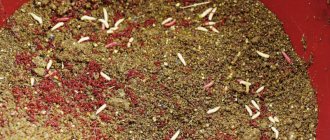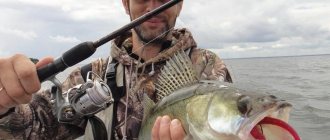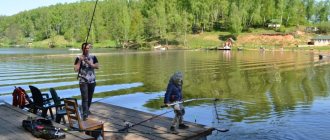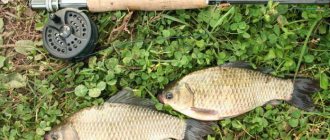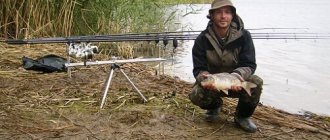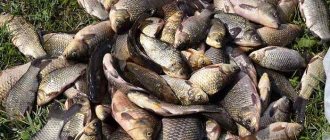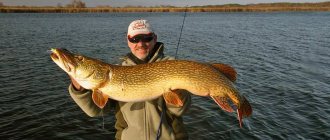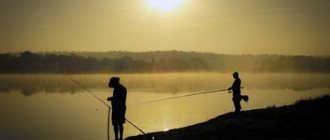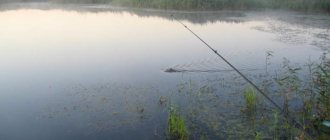Promising places for catching rudd in autumn
Perhaps the most important aspect of fall rudd fishing is choosing the right location. In summer, it is enough to find an area near the reeds where there is algae at the bottom, and you can lay out your fishing rods and start feeding.
In the fall, it is necessary to find areas where, on the one hand, the water has not had time to cool too much, and on the other hand, so that there is vegetation in this place. It is best to find some creek where there is a coastal drop with a sharp change in depth. The ideal option would be to have a shell and some algae at the bottom. The depth in such a place should be 2-2.5 meters. Here you can catch rudd with a fishing rod throughout October and a little in November, until the first morning frost.
Autumn sometimes brings many sunny and relatively warm days. If the wind is still slightly southerly, then you can safely go fishing for rudd. Another promising place would be a quiet section of the river, along the banks of which reeds grow. Casts should be made close to the reed wall or a little further, to a deeper area.
Rudd loves places with little or no current. Therefore, you should not even try to catch it in areas with medium and fast currents, especially in the fall. When scanning the bottom, it is better to find the boundary between vegetation and a clear area. If you feed this place a little, you can count on a good, by autumn standards, bite.
If pondweed or cattail grows in the selected area, then with a high degree of probability we can say that our target lives here. It is well known that the rudd does not like long journeys. She prefers to stay in the same area for a long time. If the food supply in the form of underwater plants and larvae is in sufficient quantity, then this type of fish will be constantly near such food.
On cloudy and fairly cool days, rudd are better caught from the bottom. On sunny and calm pleasant days it can be caught in the water column. Here you can experiment by changing the depth. Sometimes such techniques bring good and even unexpected positive results. If you catch rudd in the water column, then the most promising way is to lower the bait into the middle horizon. As a rule, there are the most bites here in the fall.
You should never forget that rudd often coexist with perch. These fish have almost the same food supply. Therefore, if you manage to catch a perch, then, most likely, there should also be rudd in this place. The truth is that sometimes it happens the other way around, when the perch displaces the rudd. If only striped robbers are hooked, then it is better to move a little to the side and try to fish there.
DIY bait for rudd
Since the first days of May, hundreds of fishermen have been sitting in shallow bays in order to catch this golden beauty with red fins. Even earlier, in April, you can climb to the high shore and peer into the water surface of a bay or lake, and see quite numerous schools of rudd there - characteristic fins and golden “highlights” - yes, that’s it.
Rudd is an amazing fish that can be caught by almost all known fishing methods: a float rod and its variations, a bottom rod, in particular, a feeder, fly fishing, and also spinning. The last two methods do not require the use of bait, so what is written below will concern fishing with a float rod and feeder.
In summer, rudd in dense water thickets are caught with a fly rod using grasshoppers, without using a sinker. Such fishing itself is mobile and does not require complementary feeding either.
Rudd catches from May to October can be simply amazing if the reservoir meets its needs for living conditions. It is also unpretentious to baits and can be caught very well if you find the right place to fish. I want to say right away that I bait the rudd not in order to actually “feed” it, but in order to have an advantage over other fishermen nearby, in order to get the best result possible.
Although the result is not the main thing, and I agree with that. The main thing is the process, which, when catching rudd using the right bait, is very intense and dynamic - not like idle glances at the float in anticipation of a bite, when schools of fish stand closely under the neighbor’s float 10 meters to the left or right, because he has the right food.
There are also often times when, after half an hour of active biting of a palm-sized rudd, a small one becomes on the point, and a large one hits rarely or even to the side... This is where a well-timed bun of good food and a break of 10 minutes will help.
A short note: It is the right choice of a suitable water area that can give you at least a satisfactory result, and this should be approached carefully - with binoculars and polarized glasses we inspect bays, bays, overgrown areas of lakes and the like.
Rudd responds well to bait, but the duration of preliminary baiting should be longer than for other fish. If it is possible to bait at the fishing point for at least a few days, you should do so. After all, there is a possibility that a large rudd, whose size can be quite significant, will also begin to feed in the important place... it likes sweet canned corn with a vanilla aroma.
The rudd feeds primarily on the surface of the water, as evidenced, in particular, by the structure of its mouth. She greedily grabs insects, various larvae, caterpillars falling into the water, and also eats small mollusks, algae and other small aquatic life. Based on this, it immediately becomes clear how the bait mixture that we throw at the fishing point should work, and what components it should consist of - it should work immediately when it falls on the surface of the water.
When we catch rudd “on a float”
I know two ways to effectively bait rudd when fishing with a float rod:
- The mixture should be liquid and quickly dissolve in water, forming an aromatic cloud of turbidity that does not settle for a long time.
- The mixture should be almost dry, float on the surface, and when wet, slowly sink to the bottom.
For the first method, you will need dust-like components - flour of various cereals, coconut flour, finely ground biscuits, dry sifted clay, cocoa, milk powder, cinnamon, vanillin, etc. The finished mix should be heavily moistened. Bread or crackers heavily soaked in water also work well. The bait mix must be rubbed through a fine sieve.
For the second method, floating components are suitable - breadcrumbs, bran, various kinds of seeds, cake, oat flakes, coconut flakes, hemp, cumin, coriander, dill... You should only take into account that with surface movement of water (in the presence of wind and waves) floating The bait can move around the water area and “pull” the fish along with it.
As for flavorings, spices, except dill and cinnamon, should be used in autumn and spring, and in summer vanillin (or vanilla sugar) will be sufficient.
According to its characteristics, the mixture for baiting rudd should be similar to bait for bleak, and work in a similar way.
Undoubtedly, you should understand how the individual components of the mix work, for example: Any cereal flour is a good binding component, which, moreover, quickly absorbs moisture, but it quickly sinks to the bottom (like crackers). Cocoa only flavors and colors the mixture, adding a bitter taste. Powdered milk and soaked bread produce a fairly strong cloudiness. Ground seeds, bran are well “charged” with the aroma of any attractant, and so on...
I think it is inappropriate to write ready-made recipes and proportions. Knowing how one or another component works, you can easily create the necessary proportions yourself and practically select a mixture that will effectively feed rudd. Moreover, preparing a mix is a truly creative process that brings pleasure... and helps improve your fishing results.
The only problem is that you need to choose the right place to fish, and then you will catch redfish.
We catch rudd from the surface.
For myself, I separately feed rudd with bread or bread crumbs, as well as floating maggots and caster.
Baiting with pieces of bread is also possible only when there is no significant surface movement of water (in bays this almost always happens). The fish attacks the bread, it gradually becomes soggy, and thereby attracts rudd, which feeds in the upper layers of the water due to the light turbidity that forms, as well as small particles of bread.
I use bait with floating maggots and caster when a light breeze brings all sorts of aquatic debris into the bay. A dirty film forms on the water, which is like a carpet of food for fish, because there are fallen insects, spider bugs, small mollusks, etc.
Pull the sinker up to the float, and attach a floating maggot or caster to the hook - throw it onto the surface film, and the bait floats on the surface. Having previously thrown several floating larvae to a point with a slingshot or hand, you can expect a confident bite from the rudd. Also in such conditions, catching rudd with a pickerel with a floating feeder is effective (more about the feeder below).
You can make maggots float by filling them with water so that they do not drown for 5-10 minutes. After this, they instinctively draw air into themselves and begin to swim without losing mobility, which greatly attracts the rudd. In case of high water activity, only caster should be used.
Some maggots and casters of the same type will sink when baited, but this is only for the good - they will only attract the attention of fish that are deeper or in cover.
Regarding baiting technique: it should be said that rudd is not bream, and will not dig into a pile of food. The bait is supplied with each cast of the rig (or vice versa, after removing the rig from the water), in small portions, precisely, using a slingshot, or by hand. This way we will maintain a constant cloud of turbidity at the fishing point and food competition among fish, and bites will occur immediately after splashing down the equipment. It is also important to understand the specific behavior of the rudd at the “table” with food - it will never be in the “center of events,” that is, where the little things greedily rush to pieces of bait (this is especially true for large specimens). She stays nearby and feeds from the edges of the “table” - is it clear where to throw the equipment?
Catching rudd with a feeder
You can successfully catch rudd with a feeder, using both a floating and a bottom feeder with food. Although this method is rarely used, let’s consider some specifics.
With food for floating feeders, everything is more or less clear, because its characteristics will not differ from bait for fishing with a float rod.
But to bottom catch rudd using a feeder, and effectively bait it, you need to know a lot about the properties of the components of the bait, and about the feeding habits of the fish, in this case the rudd. The latter hardly feeds at the bottom (let alone from the bottom), so we must present it with a mix that, having fallen to the bottom in the feeder, works in all layers of water. This effect can be achieved by using active, under-moistened bait with a large content of floating components (coconut shavings, ground popcorn, bran, crackers, crushed sunflower seed husks, caster) - thanks to this, the mix at the bottom will immediately “explode”, releasing oxygen bubbles, and floating components will form a “cloudy column” of bait from the feeder to the surface. And the effect is not only visual... All of the above components perfectly absorb smell and taste - by adding an attractant, we will “charge” them with additional attractiveness, and, possibly, nutritional value.
We should not forget here that the design of the feeder equipment should provide for the removal of the bait to the edges of the feeding “table”, away from the greedy little things - exactly where the cautious large rudd stands.
Conclusions and considerations
In my opinion, the peculiarity of food for rudd is the maximum cheapness and simplicity of the main components, and further improvement of their nutritional characteristics by adding various additional components and attractants. For example, in May I used bait based on sugars, biscuit and bran, added vanilla and strawberry syrup to the water - and got excellent results.
Almost any budget branded bait is suitable for baiting rudd (especially the “geyser”, “volcano” or “explosive” series), you just need to first check its composition and operation, and, if necessary, modify it (sieve, add some individual components or attractants , additives, etc.).
But is it necessary to use a ready-made mixture if it needs to be modified? — It’s better to cook it yourself “from scratch.”
Many will say that when catching rudd, bait is not needed, and, to some extent, they will be right. After all, “running”, mobile fishing for this fish is really effective and interesting. But still, when you want to catch a red-finned beauty well, sitting in one place, but she doesn’t know about it, you should also remember about bait for her, re-read this small note - perhaps some information will be useful.
Catching rudd using bait will make your fishing in any place active, intense, and productive. Especially considering the opportunity to catch a trophy rudd.
In the future, we will also understand the features of baiting other, specific species of fish from the perspective of active amateur fishing.
Thank you for being with us. If you have anything to add or object to, we are waiting for you in the comments! No tail, no scales!
Thank you for fishing with us! Or not yet? Yandex.Zen Facebook
Tags
rudd float bait feeder
Fishing rod equipment for autumn catching rudd
Depending on which place is chosen, one or another version of the float rod is used. For example, if the area is densely surrounded by reeds, then it is better to use a longer Bolognese rod of 6-7 meters. With its help, you can easily cast the equipment to the desired point. It is only necessary to remove the reeds a little on the sides so that there are no obstacles when casting.
To ensure that the tackle flies well and accurately, you can use a self-loading float when fishing in such conditions. It can be sliding. In this case, loading is performed as follows:
If you fish with a rig with a blind type of float attachment, then the loading is performed in the lower part of the keel:
If you manage to find an area without a current among the water lilies, located not far from the shore, then you can try fishing with a rig without a sinker. Its advantage is that the bait will slowly sink, thereby attracting fish in the water column. On sunny and calm days, this method of presenting baits can lead to good results. The result will be a plausible imitation of a slowly falling larva.
Naturally, with the appearance and strengthening of wind, it will become impossible to fish with a rig without a sinker. Therefore, in this case, you should attach the weights to the fishing line. To make the bait float in the water column, you can attach a foam ball to the hook and change the leash to a longer one. We choose the length experimentally.
We attach an inertia-free reel with a fishing line with a cross-section of 0.18 mm to the Bolognese fishing rod. Special requirement for fishing line. It must be quite rigid and have no memory. It is not always possible to find thin line that remains level when fishing using a reel. Therefore, preference in such cases should be given to high-quality and branded fishing lines that have been repeatedly tested on the pond.
As for the methods of attaching weights, if we use ordinary floats, without self-loading, then the best option would be one olive, which is limited by stoppers on the sides. Using the stoppers, you can adjust the distance from the weight to the leash. If you need to move the equipment so that it sinks smoothly, then raise the stops higher. If we want the rig to quickly fall to the bottom, then we lower the lower limiter all the way to the leash loop.
It is advisable to use 3-5 pellets rigidly attached to the fishing line in cases where the rudd is active and is not afraid of the resistance of the equipment when biting. This option for attaching weights is most often used in warm weather in the first half of September.
We pay special attention to hooks. In the autumn, rudd is most often caught on maggots and less often on bread and bloodworms. Therefore, priority is given to hooks made of thin wire No. 14-16 according to the international classification.
Baits for fall fishing for rudd
With the onset of cold weather, the number of baits on which you can catch rudd decreases. If in the summer it was well caught using pearl barley, dough, semolina, wheat grains and other vegetable baits, now it is better to use maggot, in some cases dough or bread, a small worm and bloodworms.
Experience has shown that maggots work best in cold water. One or two larvae are placed on the hook, depending on the size. It is impossible to say for sure how many maggots the rudd will peck more actively. Sometimes only one small larva on a small thin hook tempts the fish, and it bites only in this way of presenting the bait.
In some cases, it is necessary to plant clusters of 3-4 larvae. It is very useful to have not only white, but also red and yellow maggots, as well as casters. It happens that rudd only bite on caster or red maggot. This point must be taken into account when preparing for fishing. If you forget something, you will only regret later that you don’t have a complete set of attachments.
It is important that the maggot remains active throughout the entire time it is in the water. If a maggot on a hook quickly loses its mobility, then it is unsuitable for further fishing. The bait should be lively and constantly attract the attention of fish.
It is also important to place the maggot on the hook correctly. Often anglers pierce the end of the larva and thread it through. This is not always justified, especially when the bite is sluggish. In this case, it is better to plant the maggot like a worm in order to hide the hook as much as possible, exposing the sting a little.
One thing to take into account is that thicker maggots fall more slowly, and casters generally have positive buoyancy. Be sure to have foam balls with you so that you can apply bait to different water horizons.
When casters are planted, a juice with a characteristic odor is released from them. This juice will be the best flavoring agent when fishing for rudd. Casters are often used in combination with live maggots. Some fishermen specifically press on the dark pupa so that more liquid comes out of it.
Dung worms can be effective bait on warm days. It has been noticed more than once that on sunny days with a calm wind, rudds bite well on the worm. Small specimens should be selected so that they sit neatly on a small hook. If the rudds only eat the worms, but are not spotted, then we attach them in such a way that they are entirely on the fore-end, and the sting sticks out a little. Combining worms with maggots also helps to increase the percentage of successful strikes very well. In this case, the worm is first threaded through, and it is closed with maggots, leaving the sting open.
When fishing in mid and late autumn, bloodworms are increasingly used. It can be used as a stand-alone attachment or paired with maggot or caster. It is very important here that the hook is thin and very sharp throughout the fishing. The easier it passes through the bloodworm's body, the longer it will remain alive and active.
What to use to catch rudd in the fall
The following amateur gear is suitable for catching rudd in open water:
- Float rod;
- Spinning;
- Feeder;
- Fly fishing tackle.
What to use to catch rudd in the fall, each angler decides at his own discretion. Fishing is more comfortable using familiar gear.
Rudd on a float rod in autumn
Catching rudd in the fall with a float rod is possible before the onset of freeze-up. All types of float gear are applicable. The Bolognese fishing rod is most often used. Please note that as the temperature drops, the water becomes clearer. Therefore, it is necessary to use inconspicuous equipment. Suitable quality fishing line with a load capacity of 3 kg. Rudd is a cautious fish, and camouflage plays an important role when fishing. It is better to be located as far as possible from the promising fishing area. You can increase your casting distance using a sliding float.
The float is loaded with one sinker or with a pad. Small rudd move in schools, so when catching live bait, it is advisable to tie 2-3 hooks. Biting two rudd at the same time is not uncommon.
After identifying a promising place for fishing, bait for rudd is prepared. Delivered by feeders or thrown by hand. To attract small fish, a few handfuls of crushed cake or bread crumbs are enough.
The tackle is cast into a baited area: a window of vegetation or under the border of a reed. If a large population of rudd lives in a reservoir, then you won’t have to wait long for a bite. The fish confidently grabs the bait. It is not difficult to get caught rudd to the shore (boat).
Rudd on a spinning rod in autumn
Rudd is a predatory fish and can be successfully caught using spinning rods. Ultralight or lightweight spinning rods with a weight of about 5 g are used. They are convenient for casting small lures for rudd.
Although it is not necessary to specifically select fishing rods for catching rudd. Light baits can be cast using a bombard. This is a kind of float, which is produced with different buoyancy. Allows you to carry out wiring in different horizons of the reservoir. In the first half of autumn, rudd still stays in shallow areas, and during this period it is more convenient to fish with a floating bombard. Lures with appropriate buoyancy or 2-5 hooks for fishing with silicone baits are tied behind the bombard.
Feeding rudds in autumn
To catch good autumn rudd, you should feed it correctly. The best baiting tactic is to fish one or more selected areas first. We are waiting for the first individuals to bite. If there are rudd in a given place, then we proceed to the starting feeding.
We use a fine mixture for cold water. Roach or universal bait with a not very strong aroma is suitable. The main thing is to properly moisten it and roll it into balls. These balls must then be accurately thrown to the fishing point. After landing, they should crumble evenly.
It is very effective to add maggots and chopped worms or bloodworms to the mixture. In this case, you can count on larger individuals being suitable. You also need to take into account that there may be perches in this place. If they are in large quantities, then it is better to change the location.
The number of balls for starting feeding is 3-4 pcs. the size of a tangerine. Next, we feed the fish depending on its activity. On average, we throw 1 ball every half hour. This will be quite enough for autumn fishing. Add the animal component to the balls in pinches. It is not necessary to fill each ball with bloodworms or maggots. Here we look at the situation.
If we catch fish from the bottom, then we make the “tangerines” more dense so that they crumble only when they touch the bottom, and not on the water. When fishing in thick water, it is better to make the balls more loose so that they disintegrate before they touch the bottom.
Tips and interesting facts
- If small baits such as bloodworms or maggots are used, it is preferable to place them on the hook in bunches - 2-3 or more larvae. A voluminous bait is more likely to attract the attention of large fish. In addition, using bunches of bloodworms or maggots allows you to reduce the number of small fish bites. If the bait in the form of several larvae on one hook brings few bites or does not bring them at all, you can try planting them one at a time.
- On warm sunny days, rudd can rise to the surface, where the water is warmer. Therefore, in such weather you should definitely fish the upper horizon. If the autumn is warm and there are still flying insects in November, the probability of finding rudd in the near-surface layer of water is especially high.
- Wading boots or waders can be very useful when fishing for rudd in the fall. They are especially relevant when fishing with a fishing rod with a side nod.
The process of fishing rudd on a float
If you manage to find a more or less spacious place where the reeds do not interfere, then you can use two fishing rods. If casting is inconvenient and you constantly have to strain so as not to catch the neighboring equipment or reeds, then it is better not to torture yourself, but to fish with one fishing rod.
After the starting feeding, we begin fishing. Rudd bites most often occur when the bait sinks to the bottom and when you play along a little with a nod. Another option is to throw a small piece of bait at the fishing spot.
When fishing, it is very important to monitor the preferences of the rudd. In autumn, you should actively experiment with baits and fishing techniques. Sitting and just waiting for bites is not the best tactic. It is better to try changing leashes to longer or thinner ones. Changing the fishing point helps if the limit of rudd caught at the previous one has been exhausted.
Changing the fishing horizon often helps, especially in sunny weather. Therefore, it is important to use foam and caster to lift the bait to the upper horizons.
It happens that rudd is caught only near reeds or near algae. In such cases, you can throw one fishing rod on the left side, under the reeds, and the second in the opposite direction, also under the reeds.
It is very important that the tackle enters the water as quietly as possible, so that there are no loud splashes. In autumn, the fish becomes more cautious and will avoid such baits.
Another useful method when fishing for rudd in cold weather is to slightly pull the tackle towards the shore. We made 1-2 turns of the coil and stopped the movement. After a pause of 5-7 seconds, we continue to pull the rig to the shore. Sometimes this non-standard fishing method leads to bites. It is known that the rudd is still a bit of a predator. It is caught well with small silicone baits and small spoons. We will do a kind of dragging along the bottom. Such a presentation of baits may interest fish. In this case, it is better to use small worms and maggots as bait, which remain mobile after such postings.
